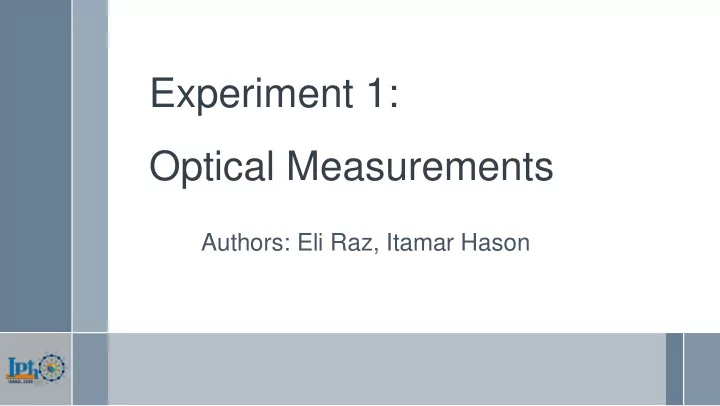

Experiment 1: Optical Measurements Authors: Eli Raz, Itamar Hason
Motivation: Rainbow Rainbow phenomenon, result of: ● Minimal deflection angle off a water drop ● Refractive index dependence on the wavelength Use the minimal deflection angle phenomenon to obtain the optical parameters of a disk, a prism and a diffraction grating with superb precision
The Leading Principle: Extremum Experimental Method • Ordinary experimental method: • Measure experimental variables • Extract physical quantity: solving equations, regression • Sensitive to errors in all all experimental variables • Alternative method: measure at an extremal setting • Achievable with great precision • Supplies further equations: solve for less-easy-to-measure variables • Extract physical quantity using subs bset of the experimental variables
Parts of the Experiment ● Disk, Mimicking the rainbow effect, with one wavelength Part Finding refractive index with superb precision ● A Multiple orders ● ● Diffraction grating Part Finding the ratio 𝜇/𝑒 with superb precision ● B ● Multiple orders Prism ● Part Finding refractive index with superb precision ● C
Part A: The refractive index of a disk Diode ● Measure deflection angle as a function of Laser the incident angle ● Snell ’ s law with regression is possible, suffers from bad precision for the incident angle due to the width of the ray ● Minimal deflection angle is easy to find despite the width of the ray ● Refraction angle only is enough at the minimal deflection angle
Part A: The refractive index of a disk • Use multiple reflections to find the refraction 3 Laser angle with high precision • Obtain the refractive index with super precision • Analysis is possible with “ higher order 2 rainbows ” as well • Perform the same analysis on different rainbow orders to get an estimate on the error of the refractive index (<0.5%)
Part B: Diffraction grating parameters L L 1 2 m 1 m 1 ● Regular method requires knowing the incident angle 𝛽 m 2 H m 2 which is difficult to measure with good precision grating Laser ● Finding the incident angle where the maximum of order 𝑛 is at a minimal deflection angle, gives a second equation which allows to avoid measuring the incident angle ● The students are required to repeat the measurements L L at various maxima orders h 3 H H m 3 grating grating h 4 Laser Laser m 4
Part C: The refractive index of a prism ● Again, measuring the incident angle is difficult ● Using the minimal deflection angle allows to relate the incident angle and the deflection angle, overcoming the difficulty in measuring the incident angle L Laser prism min h
Summary • Original and sophisticated experimental method • Superb precision with minimal obstacles • Direct methods – possible but less accurate • Students are tested for: Creativity, Physical understanding, Experimental technique
Recommend
More recommend